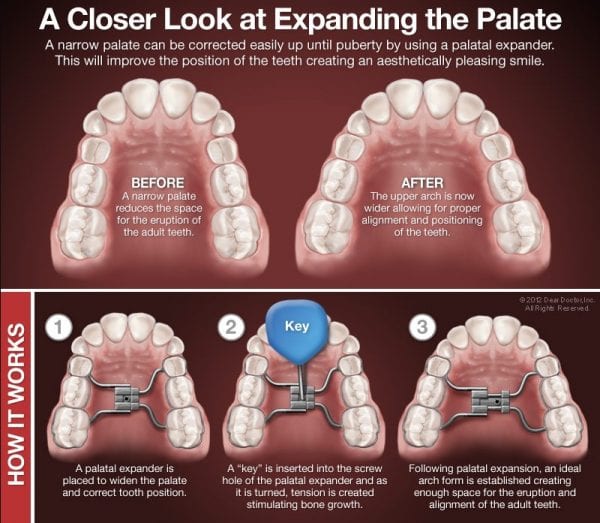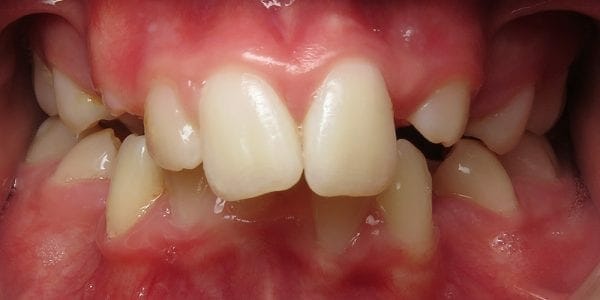What are the Benefits of a Palatal Expander?
Why Do Young Children Need Orthodontic Treatment?
The American Association of Orthodontics recommends children receive an orthodontic consultation starting at the age of 7. This is about the time the first adult molars have erupted into the mouth and established the back tooth bite relationship.
Early evaluation is beneficial because a young child’s mouth is still forming and growing at this age. This presents orthodontists with a unique window of time to address issues with the jaw size and jaw structure in an easier, more comfortable, and more conservative way than if the child was much older.
Around 7 years old, the child is beginning the mixed dentition stage of oral growth, when the mouth possesses both baby and adult teeth.
During this stage, a well-trained doctor will be able to determine if a problem exists or is anticipated based on how the adult teeth are starting to grow in and how the child’s growth pattern is developing.
At the consultation appointment, the doctor may recommend proceeding with treatment immediately if a near-term problem exists. If no teeth are in immediate danger, the doctor may advise waiting some time to evaluate further tooth and jaw development prior to starting treatment.
Naturally, each case requires a different plan of action. If tooth and jaw development look good, children might not need any orthodontic intervention at all.
What is a Palatal Expander?
 A palatal expander is used to increase the width of the upper jaw by widening the growth plate that runs front-to-back down the center of the jaw. It is most used in cases where a back tooth crossbite is present (when the upper jaw is narrow relative to the lower jaw).
A palatal expander is used to increase the width of the upper jaw by widening the growth plate that runs front-to-back down the center of the jaw. It is most used in cases where a back tooth crossbite is present (when the upper jaw is narrow relative to the lower jaw).
Lower jaws do not have a growth plate in this way, so the lower jaw cannot be expanded like this.
Palatal expander devices, through slow and gentle widening of the upper jaw, can also give additional room in the upper arch for eruption of teeth that may be crowded or potentially impacted under the gums.
Palatal expanders are one of the most tried and true orthodontic devices and are safe and effective. Parents should not be alarmed at the thought of their child’s jaw widening in this way.
During early childhood, the right and left halves of the palate (upper jaw), which are together known as the maxilla, have not yet fully fused. Therefore, expanders work to reshape the maxilla before these two parts join permanently, after which the maxilla can only be expanded by surgical methods.
Achieving ideal upper and lower jaw width relationships not only helps to create a properly functioning bite, but widening the upper arch can also “broaden” the smile and make it more aesthetically pleasing.
While orthodontists can use palatal expansion in some teenagers, it is not as predictable or effective since teenagers’ palates may be fully formed at this point.
Because of this, it is crucial for young children to undergo this type treatment at a relatively young age (between 7 and 12 year old) for optimal results.
How Does it Work?
A palatal expander, which is custom made for each patient, fits easily onto the top of the back, upper molar teeth. It effectively works to expand the upper jaw to its ideal width.
Using gentle pressure over time, the mouth is widened as instructed by the orthodontist.
On average, a patient usually spends 3 to 8 months in a palatal expander.
Can Braces or Clear Aligners Be Used Instead for Palatal Expansion?
The short answer is no. Braces and clear aligners are important tools that orthodontists use to move teeth. They, unfortunately, do not predictably or effectively widen the upper jaw growth plate like an expander does.
If your dentist or orthodontist is using braces or clear aligners for “expansion”, they are merely tipping or tilting the back teeth towards the cheeks, not widening the upper jaw. This may be well and fine in cases where a simple tipping movement is all that is required for correction. However, in cases with true jaw size mismatch, an expander should be used instead for the best result and long-term stability.
Who Needs a Palatal Expander?
Naturally, one of the most pressing questions parents have regarding palatal expanders is: “How do I know if my child needs one?”
While there are some tell-tale signs, the quickest answer to this question can only be given by a board-certified orthodontist, such as Dr. Redford or Dr. Burke.
Only a trained eye will be able to appropriately examine and recommend a device such as an expander for treatment purposes.
Everyone has a different mouth, so the need for this type of treatment must be decided by an orthodontist on a case-by-case basis during a consultation with one of our doctors.
Schedule a Free Consultation Today
Burke & Redford Orthodontists offer the perfect opportunity for this question to be answered free of charge. Our experienced doctors walk patients through all possible treatment paths during your complimentary consultation.
You may schedule one for you or your child today by calling (951) 699-8011 during normal business hours or online through our website anytime. We have beautiful, modern offices in Temecula and Lake Elsinore.
What Does a Palatal Expander Treat?
The palatal expander is used as a means of intervening early in the growth of the child’s mouth before existing issues get worse or future issues can take root.
Palatal expanders effectively treat the following:
Misaligned Jaws
A palatal expander can aid in gradually expanding an upper jaw that is too narrow relative to the lower jaw.
Maladaptive shift in the bite
When an upper jaw is too narrow, a patient will commonly shift their lower jaw to either the right or left when biting down on their back teeth. This can result in asymmetric tooth wear and is correlated with development of jaw problems later.
Use of an expander device to properly coordinate the width of the upper jaw relative to the lower jaw will generally resolve the shifting problem when biting down.
Crowded teeth
 A small upper jaw often leads to substantial malalignment or crowding of teeth. Expanding the upper jaw can create additional room for teeth to fit properly.
A small upper jaw often leads to substantial malalignment or crowding of teeth. Expanding the upper jaw can create additional room for teeth to fit properly.
Impacted teeth
Upper canine teeth becoming impacted underneath the gums is one of the more common problems orthodontists treat. Expansion of an upper jaw, along with other interventions, can help reduce the risk of canine impaction.
If you think you or your child may benefit from exceptional orthodontic treatment, a free consultation may be scheduled at Burke & Redford Orthodontists online or by calling (951) 699-8011.
Our doctors, Dr. Redford and Dr. Burke, have decades of combined expertise and excel in quality patient care. Our five-star practice is dedicated to making orthodontic care an enjoyable and stress-free experience for every patient.